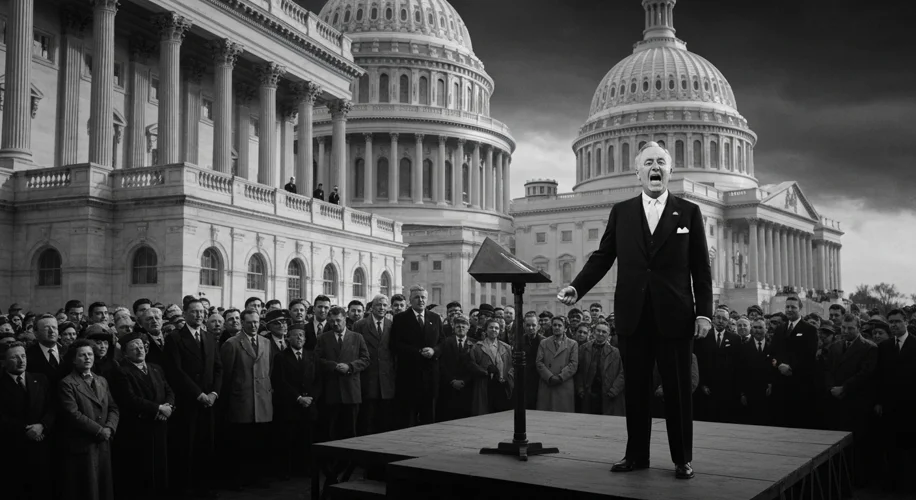The United States Constitution, a document etched in parchment and ideals, has endured for over two centuries. Yet, its interpretation has been a constant dance between rigidity and adaptability. At the heart of this enduring debate lies the concept of “Living Constitutionalism,” a philosophy that views the Constitution not as a static relic, but as a dynamic, evolving document, capable of responding to the ever-changing needs of society. While often associated with modern liberal jurisprudence, the roots of this interpretive approach run deeper, with Franklin D. Roosevelt and his New Deal policies standing as a pivotal moment in its evolution.
The early republic, steeped in the revolutionary fervor and the Enlightenment’s emphasis on natural rights, largely favored a more literal interpretation of the Constitution. The framers, wary of unchecked government power, sought to establish a clear framework, believing that the original intent of the document should guide its application. This “originalist” or “textualist” approach held sway for much of the 19th century, shaping legal discourse and judicial decisions.
However, as the nation grappled with the seismic shifts of industrialization, urbanization, and increasing social inequality, the limitations of a rigidly interpreted Constitution began to surface. The Gilded Age, with its vast fortunes amassed by a few and widespread poverty endured by many, exposed the cracks in a legal framework seemingly ill-equipped to address the complexities of a burgeoning industrial economy. Labor disputes became violent, monopolies stifled competition, and the lives of ordinary Americans seemed increasingly dictated by forces beyond their control.
It was into this crucible of economic and social upheaval that Franklin Delano Roosevelt ascended to the presidency in 1933. The nation was mired in the Great Depression, a catastrophe that had shattered dreams and plunged millions into despair. Roosevelt, a charismatic figure with an unshakeable optimism, promised a “New Deal” – a bold and sweeping program of government intervention designed to alleviate suffering, restore economic stability, and reform the very foundations of American capitalism.
The New Deal’s legislative achievements were staggering: Social Security, the Securities and Exchange Commission, the Civilian Conservation Corps, and countless others. But these initiatives were not without their legal challengers. The Supreme Court, at the time largely composed of conservative justices steeped in originalist thinking, viewed many of these programs as unconstitutional overreaches of federal power, striking down key pieces of New Deal legislation. This period of intense legal conflict, often dubbed “the switch in time that saved nine,” marked a critical juncture.
Roosevelt, frustrated by the Court’s opposition, famously proposed his “court-packing” plan in 1937. While ultimately unsuccessful in its overt form, the political pressure exerted by the President and the shifting tides of public opinion created an environment where the Court began to reconsider its stance. Gradually, the composition of the Court changed, and with it, its interpretive philosophy. Justices appointed during the Roosevelt era brought with them a different understanding of the Constitution – one that acknowledged its capacity to adapt to new realities.
This shift ushered in an era where the Constitution was increasingly viewed as a living document, its broad principles capable of being applied to unforeseen circumstances. This philosophy, living constitutionalism, suggests that the meaning of constitutional provisions is not fixed by the intent of the framers, but can evolve through societal changes, judicial interpretation, and the ongoing democratic process. The New Deal, therefore, can be seen not just as an economic recovery program, but as a catalyst that fundamentally altered how Americans understood their foundational law.

The legacy of living constitutionalism is profound and, at times, contentious. Proponents argue that it allows the Constitution to remain relevant in a rapidly changing world, ensuring that it can protect citizens from new forms of harm and promote evolving societal values. Critics, however, warn that it can lead to judicial activism, where unelected judges impose their own policy preferences under the guise of constitutional interpretation, thereby undermining democratic accountability.
Examining the historical context of the New Deal reveals that the debates surrounding constitutional interpretation are not new. The tension between adhering to original intent and adapting to contemporary needs has been a recurring theme throughout American history. Roosevelt’s presidency, with its bold assertion of federal power and its embrace of a more flexible constitutional framework, undeniably accelerated the evolution of living constitutionalism, forever altering the relationship between the people, their government, and the enduring document that binds them.
The story of living constitutionalism and Franklin D. Roosevelt is a powerful reminder that the Constitution is not a static monument of the past, but a living testament to the ongoing American experiment – a document that, like the nation it governs, must constantly adapt to the challenges and opportunities of the present.

